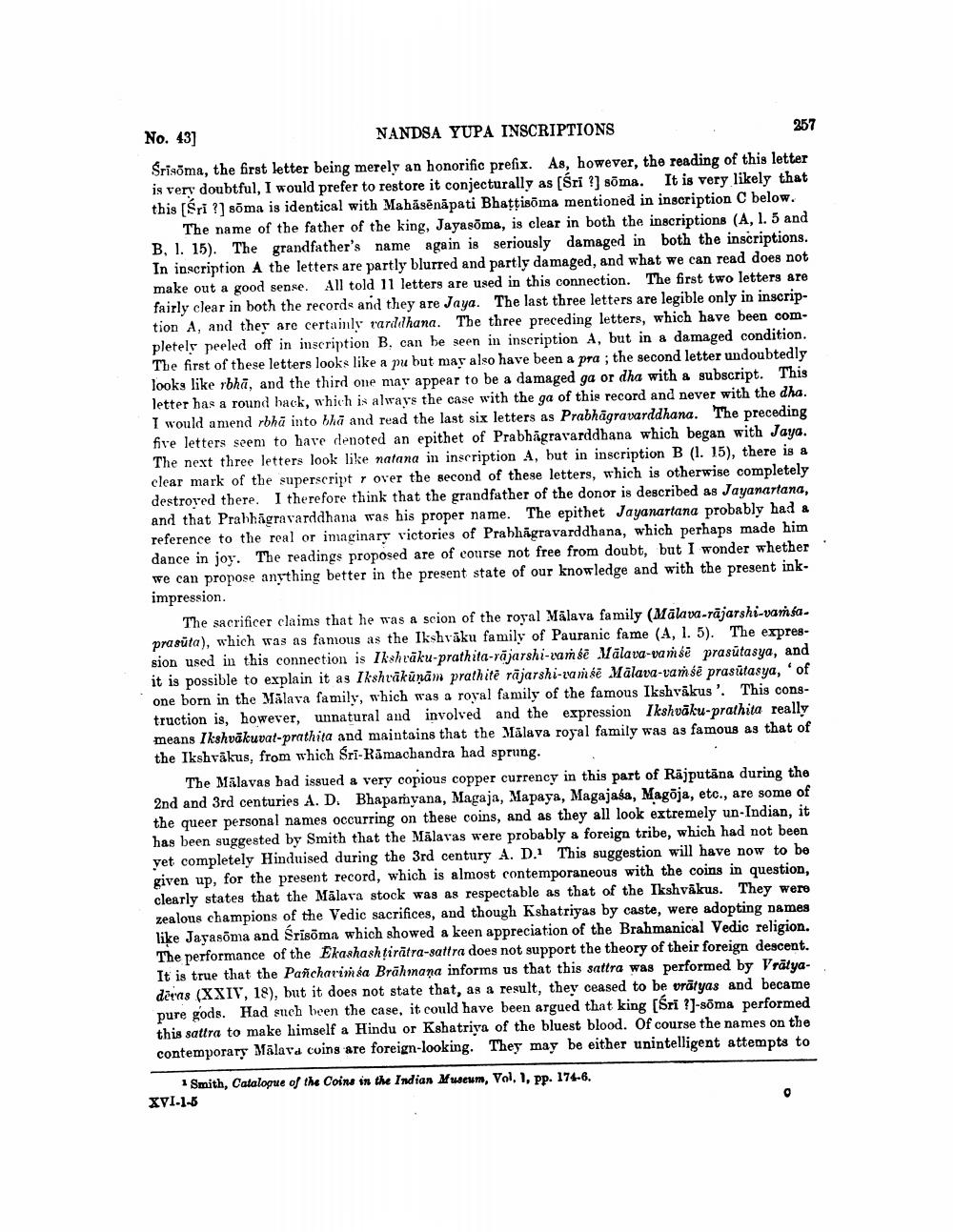________________
No. 43] NANDSA YUPA INSCRIPTIONS
257 Srisõma, the first letter being merely an honorific prefix. As, however, the reading of this letter is very doubtful, I would prefer to restore it conjecturally as Sri ?] söma. It is very likely that this [Sri ?] sõma is identical with Mahāsēnāpati Bhattisoma mentioned in inscription C below.
The name of the father of the king, Jayasõma, is clear in both the inscriptions (A, 1. 5 and B, 1. 15). The grandfather's name again is seriously damaged in both the inscriptions. In inscription A the letters are partly blurred and partly damaged, and what we can read does not make out a good sense. All told 11 letters are used in this connection. The first two letters are fairly clear in both the records and they are Jaya. The last three letters are legible only in inscription A, and ther are certainly rarddhana. The three preceding letters, which have been completely peeled off in inscription B. can be seen in inscription A, but in a damaged condition. The first of these letters looks like a pu but may also have been a pra; the second letter undoubtedly looks like rbhā, and the third one mar appear to be a damaged ga or dha with & subscript. This letter has a round hack, which is always the case with the ga of this record and never with the dha. I would amend rbhā into bha and read the last six letters as Prabhāgravarddhana. The preceding five letters seem to have denoted an epithet of Prabhāgravarddhana which began with Jaya. The next three letters look like natana in inscription A, but in inscription B (1. 15), there is a clear mark of the superscript r over the second of these letters, which is otherwise completely destroved there. I therefore think that the grandfather of the donor is described as Jayanartana, and that Prabhāgravarddhana was his proper name. The epithet Jayanartana probably had a reference to the real or imaginary victories of Prabhägravarddhana, which perhaps made him dance in joy. The readings proposed are of course not free from doubt, but I wonder whether we can propose anything better in the present state of our knowledge and with the present inkimpression.
The sacrificer claims that he was a scion of the royal Mālava family (Mālava-rājarshi-vamsa. prasūta), which was as famous as the Ikshvāku family of Pauranic fame (A, 1. 5). The expression used in this connection is Ikshrāku-prathita-rājarshi-vam se Mālava-vamśė prasūtasya, and it is possible to explain it as Ikshrākūnām prathite räjarshi-ra mée Malava-vaņģē prasūtasya, 'of one born in the Mālava family, which was a royal family of the famous Ikshvākus'. This construction is, however, unnatural and involved and the expression Ikshvāku-prathita really means Ikshvākuvat-prathita and maintains that the Mālava royal family was as famous as that of the Ikshvākus, from which Śri-Rāmachandra had sprung.
The Mālavas bad issued a very copious copper currency in this part of Rājputāna during the 2nd and 3rd centuries A. D. Bhapamvana, Magaja, Mapaya, Magajasa, Magõja, etc., are some of the queer personal names occurring on these coins, and as they all look extremely un-Indian, it has been suggested by Smith that the Mālavas were probably a foreign tribe, which had not been yet completely Hinduised during the 3rd century A. D. This suggestion will have now to be given up, for the present record, which is almost contemporaneous with the coins in question, clearly states that the Mālava stock was as respectable as that of the Ikshvākus. They were zealons champions of the Vedic sacrifices, and though Kshatriyas by caste, were adopting Dames like Javasoma and Srisoma which showed a keen appreciation of the Brahmanical Vedic religion. The performance of the Ekashashțirātra-sattra does not support the theory of their foreign descent. It is true that the Pancharimsa Brāhmaṇa informs us that this sattra was performed by Vrātyadēvas (XXIV, 18), but it does not state that, as a result, they ceased to be vrátyas and became pure gods. Had such been the case, it could have been argued that king (Sri ?)-soma performed this sattra to make himself a Hindu or Kshatriya of the bluest blood. Of course the names on the contemporary Mälard coins are foreign-looking. They may be either unintelligent attempts to
* Smith, Catalogue of the Coins in the Indian Museum, Vol. 1, pp. 174-6. XVI.1-5




